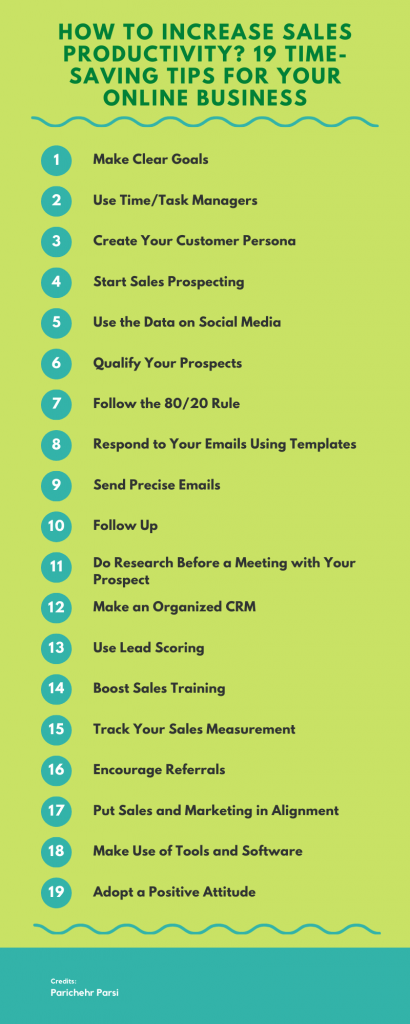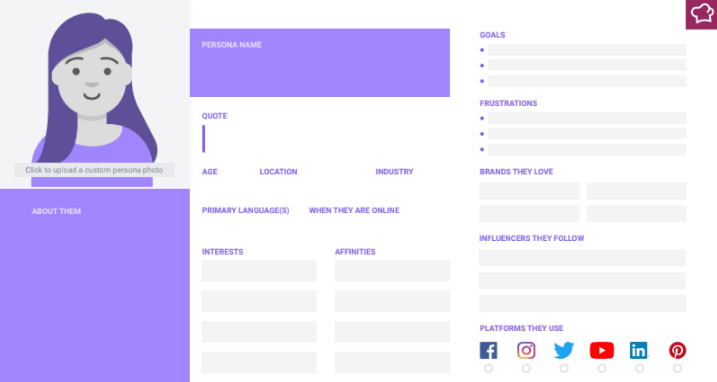The sales productivity of your online business depends on how productive you are as a salesperson.
Hopefully, it is a skill that you can acquire if you follow accurate guidelines. Then, you can grow your leads, have a successful conversion, and increase your sales productivity.
Here we will discuss some of the common issues of sales productivity and will recommend several solutions to solve the issues for higher sales productivity.
What are common sales productivity issues?
Sales productivity gets relatively low in the case challenging issues interrupt the operation. You as a salesperson should increase the productivity of the workplace and organize your sales team to achieve sales productivity at a high level.
For this to be done, you need to know these challenges that block your way to sales productivity.
Here we will put forth some of the most common issues that most of the businesses and brands are tackling:
- Not having a clear definition of goals and targets
- Having too far-fetched or too trivial goals
- Lacking strategies based on the reality of the business
- Lacking top to bottom communication
- Inefficient technology and tools that adds up to the routines instead of reducing the workload
- Change in the number of turnovers
- No or lack of in-business communication between different sections
Such issues can be more than what has already been mentioned. Educating your sales team members and learning the solutions can help you find your way through these challenging blocks.
19 time-saving tips for the sales productivity of your online business
Having identified the diverse number of issues that can affect the operations of your sales team. You should do something to remove them for better productivity. As a result, you need some tips to help you tackle the issues. Here you can find the time-saving guidelines and tips that increase your sales productivity in a short period.
Let’s first take a brief look at the infographic and then discuss each item in detail:

1. Define clear goals
Without a plan, it is hard for a sales team to know to which direction it is heading. When there is no plan, the sales performance will turn out to be weak, and therefore there will be no productivity for your activities.
If you want to increase your sales productivity, you have to set some reasonable and clearly-defined goals and make an achievable plan based on facts and realities.
You can plan a short-term or a long-term schedule and try to achieve your goals daily, weekly, monthly, and annually. The duration of your plan does not matter much. What matters is that you should stick to the plan and do your best to achieve the goals.
2. Use time/task managers
For higher sales productivity, it is extremely crucial to manage the time your sales team spends and the tasks they put more emphasis on. Controlling this requires you to automate the management of time and tasks.
The automation helps your team work more efficiently with respect to the time. The team also can achieve its goals in a more organized way and without deadline pressures.
3. Create your customer persona
A customer persona or a buyer persona is an unreal model that represents the characteristics of your large audience. The qualities and data related to a customer persona can be collected through deep web analytics and research.
With a customer persona, you can have an insight into your prospects, the way they think, the taste they like, their interests, etc.
Define your best customers. Look for the factors that have resulted in revenues for your business. These factors are hidden in your best customers’ preferences.
If you concentrate on them during planning your sales strategies, you can increase your sales productivity. Focusing on your best customers can also increase your time efficiency as you know where to spend your time.
A customer persona is important in several ways. They can provide tremendous value and insight to your organization:
- It can help your sales team to develop a better understanding of customer needs
- Your sales team can guide product development by creating features that help them get what they have planned for
- Your sales activities find an order of priority and you will know which part you should invest time and resources in
So, creating a customer persona not only gives you a better image of your future ideal customers but also organizes your sales activities. These two outcomes of customer persona result in reaching your goals.

4. Start sales prospecting
Sales prospecting is the initial step in the process of selling products and services. Without an efficient sales prospecting process, the great losses of revenue are no surprise.
During this step, you identify your target audience among your potential customers. Therefore, it can be said that the goal of sales prospecting is to establish a database of potential customers in order to convert them to real customers through communication.
If you want to know why starting sale prospecting is necessary, you should think of the fact that without leads, you have no sales, and without sales, your business is simply condemned to failure.
Sales prospecting is important in a way that it directly affects lead velocity. If you invest your time in wrong leads, you surely lose the right leads you actually need. Therefore, you need to have the right leads.
Here are the steps you should follow to get the right leads:
1. Outline your prospecting strategy
You should first define what type of leads you want to attract. To do this, focus on the demographics, characteristics, and interests of your target audience.
Based on the information that you achieve, you can identify their needs and expectations. The information can be achieved through research and referrals. So, in a nutshell, creating the preferable customer persona can show you the way your sales strategies should go.
2. Set your value proposition
The next step after outlining your prospecting strategy is to set your value proposition.
A value proposition is the statement of the advantages and benefits that your product or service can grant to your customers.
Value Proposition contains the description of your product or service, its value, and your target audience.
By stating your value proposition, you clarify what your customers will get using your product or service that they cannot get without them. It can be anything from cost-efficiency or more caring customer service.
In other words, the value proposition tells you what your ideal customers have now and what they will gain after buying your products or services.
5. Use the data on social media
One great way to know your future customers is through social media. Platforms like Facebook, Instagram, Twitter, etc. are perfect in the way that they can provide you with a lot of information.
For instance, using Instagram analytics, you can easily understand which posts have more engagement. Therefore, if you share a YouTube video on Instagram that introduces one of your products and receive a lot of engagement, you can count on the feedback and directly turn your followers into real customers.
Use social media websites to better know their audience, get feedback, engage with people, run giveaways to be able to benefit from a word of mouth marketing strategy, and turn followers to brand advocates.

6. Qualify your prospects
Qualifying your prospects means deciding which groups of leads to talk to. Wrong or weak prospects can result in leads that cannot be converted to real customers. Defining comprehensive sales and marketing strategies can help you set the qualifications of your prospects.
Different tools such as surveys, behavioral segmentation, data enrichment, etc. can work for giving you the information that you need to find the right leads
7. Follow the 80/20 rule
The 80-20 rule, or Pareto Principle, tells us that 80% of outcomes result from 20% of all causes for any event. The goal of this rule is to recognize the most productive inputs and try to consider them as a high priority.
The Pareto Principle is not suggesting that you should reduce your working hours. Though it says 20% of the efforts are enough, it does not mean the timing should be less. It means that productivity comes from 20% of the whole working effort.
So, it is necessary to look for the most influential tasks that have led to successful results and keep on focusing on them.
8. Respond to your emails using templates
One way to increase sales productivity is to use email. Managing to respond to your emails, you should arrange some specific time for your emails only.
As responding to emails requires a demanding amount of time, it is a hard and rather boring task to do every day. So, here is where technology saves your life!
Email templates are one way to automate your email responding procedure. Using email templates help you save your time and improve your development.
If you do not take this tip seriously, you will soon find yourself in the middle of loads of unresponded emails. So basically, you will have no time to devote to your other perhaps most important tasks.

9. Send precise emails
It is traditionally believed that short emails work better. But you cannot rely on traditional marketing beliefs for your online business. The modern belief to apply to increase your sales productivity is to send better and more precise emails rather than merely short emails.
Sending process-centric emails is one way you can express your goal precisely in your emails. In this process, you should:
- Set out a clear goal for your emails
- Choose a process through which you can fulfill your goal
- Make the process understandable for everyone
After doing this, you can send more precise emails that can increase your sales productivity.
10. Follow up
After reaching out to your leads and sending emails to them, you have some time to wait for their responses.
You have spent a lot of time to find the lead you think is suitable for your business after doing a lot of analysis and research.
You have done a perfect job so far and it is admirable
Now, waiting alone is not a good approach to have toward this issue.
Following up is a good way to indirectly ask the lead you have chosen to respond to your email. The frequency of following up the response depends on you and how serious the lead is for your business.
It is not just good for you to follow up to get a response. It also makes a good impression on the lead because they would think of you as a caring and respectable person/business.
So, it may happen that the lead does not want to reply back to your email in the first place but the follow-up changes their mind. Therefore, it can be said that following up is giving yourself a second chance to be noticed by your desired lead.
11. Do research before a meeting with your prospect
It happens that you should make a call or organize a meeting with your prospect. Before such a call or meeting, you should prepare for the talk, obviously. Devote as much time as possible for your preparation.
If you know your prospect’s characteristics, interests, demographics, etc. you can present your product or service in a way that they feel much more affiliated to. Using the tools that are already out there – such as the prospect’s website, social media, company profile, etc – can help you find such data.
Think of the benefits of your product or service and find a way to present them in a more convincing way. Moreover, analyze the risks that might play as a barrier on the way to the conversion of your prospect and try to find solutions for them.
In other words, spending more time doing research and finding the best solutions can remarkably boost your conversion rate. It, therefore, leads to an increase in your sales productivity.
12. Organized CRM
One way to make your sales team more time-efficient is to have a clean CRM. The data entry and the updating of the data can take a lot of time daily if you do not have an organized CRM. So, instead of spending the time on a task that needs more effort, you have lost it all on your messy CRM.
Here are the common issues of messy CRM:
- A lot of staff on your sales team waste time on the messed-up CRM daily.
- Finding information gets harder and harder as the data gets larger.
- Other staff cannot find the notes that you have taken during a call or a meeting with a prospect.
So, the wise thing to do is to spend some time cleaning up your CRM to save more time for your other tasks. Another option is the automation of your CRM so that it will be updated automatically.
13. Use lead scoring
Leads in general are divided into several categories.
- Those who are real customers.
- Leads that are going to convert to real customers soon.
- The ones that are at the beginning of the sales funnel.
- And the leads that are too uninterested to count.
Lead scoring is a system for ranking your leads in terms of their sales-readiness. Such scoring stems from your prospects’ interests, their position in the sales funnel, and how accurately suitable they are regarding your business.
A proper lead scoring system increases the possibility to pass the qualified leads through the sales funnel. It also helps your sales team to manage their time and devote it to convertible leads.
The advantage of lead scoring is that you know how to treat your prospects regarding the time to follow up. Moreover, using lead scoring, you can identify the right time for a marketing qualified lead to turn into a sales qualified lead. In addition, you can track your prospects’ communications with your messages to see if they are interested.
For instance, if you have the tools to track your prospects, you can understand how fast they are in replying to you and therefore how likely they are to convert. In other words, using lead scoring is a way toward investing more time on convertible leads rather than on reluctant or uninterested leads.
Generally speaking, automation has a lot to provide for your sales productivity. When time-related issues are solved, enough time will remain for much more important tasks.
14. Boost sales training

Proper sales training is crucial. It can boost the skills of your sales team members. Without training, your sales strategies will not be as effective.
However, it should be noted that learning skills is not enough; a sales team should know how to practically implement the acquired skill. If such a condition does not take place, the whole process has been in vain and the money and time spent are gone.
On the other hand, if the sales training is efficient from beginning to implementation, the increase in sales productivity would compensate for the money and time spent.
15. Track your sales measurement
Sales measurements or sales analytics is the act of generating insights from analyzing sales metrics. The reason for such an act is to predict future sales productivity.
Sales analysis is a careful investigation of all sales activities in order to achieve revenue outcomes and define future goals. One sales analytics activity to mention is defining objectives for your sales team using KPIs.
Without sales KPIs, it is actually impossible to know if your investments in sales are working. Tracking your sales measurements make you realize the weaknesses on the way to your sales productivity goal.
16. Encourage referrals
Today, people trust the recommendations of their friends and family instead of traditional ads. Therefore, when your real customers refer their friends to buy from you, you will get a lot of new leads that are highly likely to convert.
If you are not using your current customers as a source that can advertise your products or services at no cost, you are not doing in favor of your business. So, making use of your current customers are remarkably important on your way to attract more leads.
There are three reasons why your real current customers are important:
- Real customers that have bought your product or have used your service and have found either of them satisfactory. It is highly probable that they buy from you again. Needless to say, keeping such customers is much less expensive than trying to find new customers.
- These customers give you priceless feedback about how you work. In other words, when you see that they are back for more products or services, you can conclude that you are doing a good job for this category of customers.
- They can help you save money not just by continuing to buy from you. But also by acting as referrals and bringing leads to your business that are highly willing to convert. So, through these customers, you can get new leads that can most probably turn into real customers.
So, to encourage such referrals, you should think of ways like referral incentives. These incentives can be in the shape of coupons or credits that you grant to your customers. Giving out coupons or credits cannot compare to the benefits you get from using such a cost-effective source of potential leads.
17. Put sales and marketing in alignment
Your sales team and marketing team have to communicate together. It is wrong to think that they are two separate sections in your business. If you want to have qualified leads through increased sales productivity, you should ask these two sections to work closely together.
When your marketing team shares ideas with your sales team, the process of introducing leads to your business and converting them to real customers accelerates.

18. Make use of tools and software
As a sales manager, you should provide the required tools and software for your sales team. Such tools help you get a large part of tasks done automatically and effectively.
Though you can still keep everything done manually, you should think of the time that can be spent on other tasks to take more steps forward.
19. Adopt a positive attitude
If you want to control your sales outcomes you should have a positive and great attitude. Your attitude towards your sales activities is important in a way that it can affect achieving your goals. Your attitude can influence, support, or increase your sales.
Take a look at the top sales performers that you think as successful sales executives. Analyzing the attitudes of these people can tell you how effective it is to exhibit a positive attitude toward your business.
About The Author:

Parichehr Parsi is a born writer, and a copywriter. She currently writes Instagram marketing blog posts for SocialPros. She loves reading, doing research, and updating herself every day.


